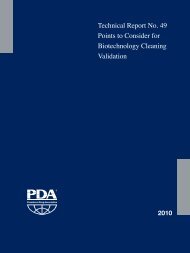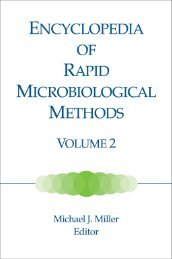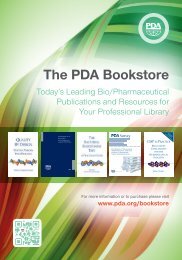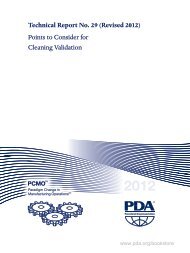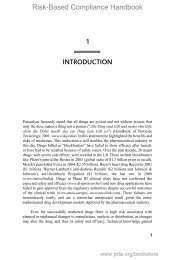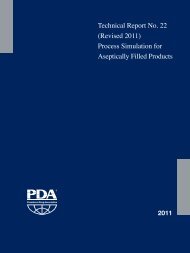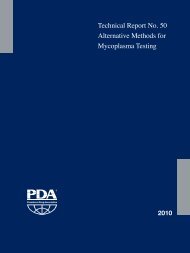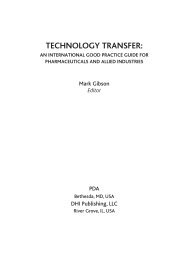Table of Contents - store.pda.org - Parenteral Drug Association
Table of Contents - store.pda.org - Parenteral Drug Association
Table of Contents - store.pda.org - Parenteral Drug Association
Create successful ePaper yourself
Turn your PDF publications into a flip-book with our unique Google optimized e-Paper software.
Technical Report No. 3 (Revised 2013)<br />
Validation <strong>of</strong> Dry Heat Processes Used<br />
for Depyrogenation and Sterilization<br />
Bethesda Towers<br />
4350 East West Highway<br />
Suite 200<br />
Bethesda, MD 20814 USA<br />
Tel: 1 (301) 656-5900<br />
www.<strong>pda</strong>.<strong>org</strong>/book<strong>store</strong>
PDA Validation <strong>of</strong> Dry Heat Processes Used for Depyrogenation and<br />
Sterilization Technical Report Team<br />
Authors<br />
Deborah A. Havlik, Hospira, Inc., Technical Report<br />
Team Leader<br />
Bruce Bear, Bear Consulting Services<br />
Stewart M. Davenport, Pfizer, Inc.<br />
Mike Davies, Lonza Biologics, UK<br />
Steve B. Folio, Althea Technologies<br />
Jill K. Giulianelli, West-Ward Pharmaceuticals<br />
Brian G. Jordan, Valsource, LLC<br />
Peter S. Lee, Mattell Inc.<br />
Hans Melgaard, Despatch Industries<br />
Christian G. Supina, Baxter Healthcare Corporation<br />
Rita Welser, Boehringer Ingelheim, Germany<br />
Robyn F. Wong, Celgene Corporation<br />
Contributor<br />
James F. Cooper, Consultant<br />
Disclaimer: The content and views expressed in this Technical Report are the result <strong>of</strong> a consensus achieved by the<br />
Technical Report Team and are not necessarily views <strong>of</strong> the <strong>org</strong>anizations they represent.<br />
www.<strong>pda</strong>.<strong>org</strong>/book<strong>store</strong>
Validation <strong>of</strong> Dry Heat<br />
Processes Used for<br />
Depyrogenation and<br />
Sterilization<br />
Technical Report No. 3 (Revised 2013)<br />
ISBN: 978-0-939459-56-8<br />
© 2013 <strong>Parenteral</strong> <strong>Drug</strong> <strong>Association</strong>, Inc.<br />
All rights reserved.<br />
Bethesda Towers<br />
4350 East West Highway<br />
Suite 200<br />
Bethesda, MD 20814 USA<br />
Tel: 1 (301) 656-5900<br />
Fax: 1 (301) 986-0296<br />
E-mail: info@<strong>pda</strong>.<strong>org</strong><br />
Web site: www.<strong>pda</strong>.<strong>org</strong><br />
www.<strong>pda</strong>.<strong>org</strong>/book<strong>store</strong>
<strong>Table</strong> <strong>of</strong> <strong>Contents</strong><br />
1.0 INTRODUCTION...................................................1<br />
1.1 Purpose and Scope .......................................... 1<br />
2.0 GLOSSARY OF TERMS.........................................2<br />
3.0 THE SCIENCE OF DRY HEAT DEPYROGENATION<br />
AND STERILIZATION............................................6<br />
3.1 Depyrogenation ............................................... 6<br />
3.2 Endotoxin Indicators......................................... 7<br />
3.2.1 Preparation and Inoculation....................... 7<br />
3.2.2 Sample Processing.................................... 7<br />
3.2.3 Recovery................................................... 8<br />
3.2.4 Results Interpretation/Endotoxin Log<br />
Reduction Calculations.............................. 8<br />
3.2.5 Glassware Depyrogenation ....................... 8<br />
3.2.6 F H<br />
–value for Depyrogenation .................... 9<br />
3.3 Sterilization ...................................................... 9<br />
3.3.1 Mechanisms <strong>of</strong> Inactivation ..................... 9<br />
3.3.1.1 F H<br />
-Value for Sterilization ..................... 10<br />
3.3.1.2 D-value and z–value........................... 11<br />
3.3.2 Biological Indicators................................ 11<br />
3.3.2.1 Biological Indicator<br />
Selection and Type <strong>of</strong> Carrier.............. 11<br />
4.0 EQUIPMENT DESIGN..........................................13<br />
4.1 User Requirements Specification ................... 13<br />
4.1.1 High-efficiency Particulate Air or Ultralow<br />
Particulate Air Filters .............................. 13<br />
4.1.2 Batch Convection Oven........................... 14<br />
4.1.3 Continuous Convection Tunnel................. 15<br />
5.0 EQUIPMENT QUALIFICATION............................17<br />
5.1 Environmental Qualification ........................... 18<br />
5.2 Uniformity <strong>of</strong> Heating Media ......................... 18<br />
5.3 Empty Chamber Temperature Distribution<br />
(Ovens and Tunnels)....................................... 19<br />
6.0 PROCESS DEVELOPMENT..................................20<br />
6.1 Process Design Approaches .......................... 20<br />
6.1.1 Overkill Design Approach......................... 20<br />
6.1.2 Product Specific Design Approach ......... 21<br />
6.2 Defining Operating Parameters ...................... 21<br />
6.3 Batch Oven Process Development ................ 21<br />
6.3.1 Developing Loading Patterns................... 21<br />
6.3.2 Loaded Batch Oven Temperature<br />
Distribution Studies ................................ 22<br />
6.3.3 Loaded Batch Oven Heat<br />
Penetration Studies ................................ 22<br />
6.4 Continuous Convection Tunnel<br />
Process Development..................................... 23<br />
6.4.1 Developing Loading Patterns –<br />
Continuous Tunnels.................................. 24<br />
6.4.2 Loaded Tunnel Temperature Distribution .24<br />
6.4.3 Loaded Tunnel Heat Penetration Studies .25<br />
7.0 PERFORMANCE QUALIFICATION.......................27<br />
7.1 Physical Qualification..................................... 27<br />
7.2 Biological Qualification .................................. 27<br />
7.2.1 Biological Indicator Testing ..................... 27<br />
7.2.2 Endotoxin Indicator Testing ..................... 28<br />
7.3 Process Equivalency ...................................... 28<br />
8.1 Routine Release ............................................. 29<br />
8.2 Preventive Maintenance ................................ 29<br />
8.0 ONGOING PROCESS CONTROL..........................29<br />
8.3 Change Control / Revalidation........................ 30<br />
8.4 Periodic Requalification <strong>of</strong> Equipment............. 30<br />
8.5 Parametric Release ........................................ 30<br />
9.0 REFERENCES.......................................................32<br />
FIGURES AND TABLES INDEX<br />
Figure 4.1.2-1 Example <strong>of</strong> Batch Convection Oven<br />
Showing Airflow................................. 15<br />
Figure 4.1.3-1 Continuous Convection Tunnel............ 16<br />
<strong>Table</strong> 5.0-1 Example <strong>of</strong> Equipment<br />
Qualification Checklist........................ 17<br />
Figure 6.3.3-1 Load Pr<strong>of</strong>ile–Batch Oven.................... 23<br />
Figure 6.4.3-1 Glass Vial Load Heat Penetration<br />
Pr<strong>of</strong>ile–Continuous Convection Oven....26<br />
www.<strong>pda</strong>.<strong>org</strong>/book<strong>store</strong>
1.0 Introduction<br />
This technical report is an u<strong>pda</strong>te <strong>of</strong> PDA’s Technical Report No. 3, Validation <strong>of</strong> Dry Heat Processes used<br />
for Sterilization and Depyrogenation which was issued in 1981. The technical report focuses on the microbiology<br />
and engineering qualification <strong>of</strong> dry-heat sterilization and depyrogenation processes and the<br />
general approach to sterilization and depyrogenation science in batch and continuous sterilizers (ovens<br />
and tunnels). This technical report is based on standard depyrogenation and sterilization science.<br />
The primary objective <strong>of</strong> the Technical Report Team was to develop a scientific technical report<br />
on dry-heat depyrogenation and sterilization processes that provides recommendations for use by<br />
industry and regulators. References to appropriate and current scientific publications, international<br />
regulatory documents, journal articles, technical papers and books are used where more detail and<br />
supportive data can be found.<br />
The Technical Report Team is composed <strong>of</strong> diverse international team <strong>of</strong> pr<strong>of</strong>essionals to ensure the<br />
methods, terminology and practices <strong>of</strong> dry-heat depyrogenation and sterilization processes reflect<br />
sound science and can be used globally. This technical report was disseminated in draft for public review<br />
and comment prior to publication to ensure its suitability as a recommendation <strong>of</strong> best practices<br />
to industry.<br />
1.1 Purpose and Scope<br />
This technical report provides information to the manufacturers <strong>of</strong> pharmaceutical products for validating<br />
dry-heat depyrogenation and sterilization processes. The concepts and methods presented<br />
within this technical report are not intended to be a regulatory standard, but rather as points to be<br />
considered during the validation <strong>of</strong> dry-heat processes. Other technically equivalent methods may<br />
exist and may be used if they can be supported by sound scientific methods.<br />
This technical report is intended to give information about current industry practices and approaches<br />
to validating dry-heat depyrogenation and sterilization processes. In addition, sections will cover various<br />
aspects <strong>of</strong> dry-heat sterilization using biological indicators.<br />
This technical report is <strong>org</strong>anized in a chronological fashion, starting with a discussion <strong>of</strong> the general<br />
concepts <strong>of</strong> depyrogenation and sterilization science which are the foundation upon which to build<br />
a robust process. This includes use <strong>of</strong> biological indicators and endotoxin indicators. Also included<br />
are points to consider in equipment design, equipment verification, process development and performance<br />
qualification for new systems and the development and validation <strong>of</strong> processes for existing<br />
systems.<br />
In the discussion <strong>of</strong> process development, particular attention has been given to the load type, loading<br />
patterns, and temperature pr<strong>of</strong>iles for depyrogenation and sterilization in both ovens and tunnels.<br />
The sections are followed by a brief discussion <strong>of</strong> items for consideration during routine processing<br />
and ongoing maintenance <strong>of</strong> the validated process.<br />
The background sections on depyrogenation/sterilization science and endotoxin/biological indicators<br />
are not comprehensive—but provide information specific to dry-heat processes. Information<br />
within the technical report is applicable to both forced hot air dry-heat batch processes (chambers)<br />
and to continuous processes (tunnels). Information within this technical report does not apply to dryheat<br />
processes used for the sterilization <strong>of</strong> oil bases and oil based products, fixed processing streams<br />
or to those processes using infrared and microwave heating media.<br />
Technical Report No. 3 (Revised 2013)<br />
www.<strong>pda</strong>.<strong>org</strong>/book<strong>store</strong><br />
© 2013 <strong>Parenteral</strong> <strong>Drug</strong> <strong>Association</strong>, Inc.<br />
1



